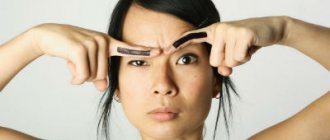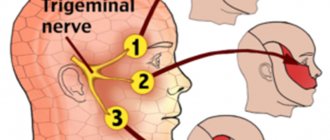In fact, every person has a difference between one half of the face and the other; they are different, but in some it is less noticeable and in others the defect is very pronounced. Appearance plays a big role in our world. This is how they “meet” a person. In the requirement column for many positions there is a “good appearance” item. Therefore, every person cares about how he looks. Sometimes, when looking at yourself in the mirror, you may notice that one cheek is larger than the other. What is this, a disease or this body structure? – this is the question asked by those who saw such a flaw. Today we will dispel all your doubts and conduct a short master class on restoring asymmetry.
Reasons why one half of the face is larger than the other
Many people complain that one side of their face is different from the other. This becomes noticeable when carefully examining yourself in the mirror or in unsuccessful photographs. Some, noticing that their cheeks are different, begin to “sound the alarm” fearing that they are sick.
Variations in the structure of a person’s face that exceed the natural differences in the right and left halves in significant quantities are considered deformities
In fact, slight asymmetry is present in absolutely every person. This is what makes our face alive, unique and inimitable.
To make sure that each person is not symmetrical, you can take several photos of your friends and cut them into two equal parts along the line of the nose in a photo editor. Now one of the right halves is “mirrored” and connected to the other, and we do the same with the left parts. Take such photographs of several people, and you will see that the faces of the right and left halves of the same person are very different.
However, different halves of the face are not always the norm. Let's look at what factors can lead to pathological changes.
Reasons why one side of the face looks very different from the other:
- Improper development of bones and joints, as well as connective or muscle tissue. Such problems can be more or less pronounced, they can only be corrected with proper makeup or plastic surgery.
- Inflammation of the cheek can also lead to its enlargement. After eliminating the problem, the face acquires normal contours.
- Severe strabismus can also develop facial asymmetry. The same applies to torticollis.
- Facial muscles can become severely distorted when nerves become pinched or die. This problem often occurs with strokes and heart attacks.
- An incorrect bite or missing teeth on one side can lead to facial asymmetry. Flux can also cause a similar problem.
- A fracture of the facial bones that did not heal properly.
- The habit of chewing, sleeping or squinting to one side is the most common cause of facial asymmetry.
There are many reasons. Some of them can be avoided by taking timely treatment and controlling your facial expressions.
Facial deformation and variants of its manifestation
Facial deformation (distortion, asymmetry of the eyes, eyebrows, cheekbones, nose) can occur in different directions, its specific types can guide the doctor in making a preliminary diagnosis and selecting the necessary examinations, then effective methods of correction, including surgical options for solving the problem, removing the causes medicines.
Facial distortion
Facial distortion most often occurs with peripheral damage to the facial nerve against the background of its inflammation. Such changes in appearance develop “suddenly and immediately”, so visits to the doctor are made urgently.
Diagnosis of damage to peripheral nerves should be carried out with the differentiation of stroke - with this pathology, a disruption of the functioning of the same nerve is observed, but according to the “central type”. You can determine what exactly caused the sudden distortion of the face yourself:
- during a stroke, a person can close his eyes tightly, while a peripheral lesion prevents this from happening (the eyelids do not close),
- if the victim is able to “pull” his eyebrows as tightly as possible, then we will be talking about an emergency cerebrovascular accident (stroke),
- sagging of the corners of the mouth and the inability to smile fully on the affected side are a characteristic sign for both pathologies.
If there is a suspicion of a stroke, the patient should be in bed, and an ambulance team should be called to the house. Any movements, especially walking or riding vehicles without special devices, are contraindicated for him - a full-fledged hemorrhage in the brain can occur, and complete paralysis can occur.
Eye asymmetry
Asymmetry of the eyes can manifest itself in strabismus, the location of one higher in relation to the other. Most often this problem occurs against the background of:
- disorders in the jaw area - incorrect structure of the lower part (or previous injuries), problematic bite, absence of several teeth,
- neurological diseases, damage to the facial nerves by inflammatory and infectious diseases.
During diagnosis, the ophthalmologist will definitely check the patient’s level of vision and measure the proportions of the entire face. Pathological deviations are considered to be the difference between the location of the palpebral fissures of 3 mm and 5 degrees.
Since eye asymmetry can appear against the background of rapid growth of a malignant tumor, a consultation with an oncologist will be required after the presence of a formation in the cranial cavities is detected.
In addition to visual examination, hardware methods are also used for diagnosis - in this case, magnetic resonance imaging of the face and x-ray of the skull will be informative.
One eyebrow is higher than the other: how to fix it
The situation where one eyebrow is higher than the other can be corrected through surgery, but here it is required extremely rarely, only in particularly advanced cases. Usually, doctors first carry out diagnostic measures, then prescribe a course of therapy (if any disease such as inflammation of the facial nerve has been identified) and only after that they recommend using the services of experienced cosmetologists and makeup artists.
In fact, such asymmetry is a normal phenomenon that is rarely associated with pathological processes. But one eyebrow can be located higher than the other due to inflammation of the facial nerves and congenital strabismus.
Often, the disproportionate location of the eyebrows indicates a person’s physiological habits - for example, when surprised or very excited, he raises one eyebrow, chews food only on one side of the jaw, constantly squints with a low level of vision.
Asymmetry in the cheekbones
Asymmetry in the cheekbones may appear due to:
- Missing teeth. The fact is that tooth loss leads to the resorption of bone partitions and the formation of a dent. As a result, the facial muscles become tense, which makes the face in adults disproportionate. If the lower jaw is missing several teeth, then the soft tissues of the face are displaced due to changes in the angle of the bones.
- The habit of chewing food on only one side of the jaw . The load on the muscles is distributed unevenly; toned (overstressed) muscles simply pull on one side of the face. Asymmetry in the cheekbones especially often appears in those people who love chewing gum.
- Night rest in a position on your stomach or side . The tissues adjacent to the pillow are constantly under strong pressure and very slowly begin to deform. One cheek becomes larger than the other, the oval of the face changes.
The problem may lie in the progression of neurological pathologies, inflammation of the facial nerves, injuries and fractures, and improperly performed plastic surgeries.
Nasal asymmetry
Asymmetry of the nose can manifest itself in the form of irregularly shaped nostrils or their different sizes, deviation of the tip of the organ from the midline. The reasons are:
- individual features of the anatomical structure of the nasal septum,
- problems in the intrauterine development of the skull bones - for example, the appearance of a “cleft lip” or “cleft palate” defect,
- unsuccessful rhinoplasty,
- mechanical injury.
Severe nasal asymmetry affects breathing, so in such cases doctors strongly recommend surgical intervention to improve the condition and functionality of the respiratory system.
One side of the jaw is larger than the other
Most often, one side of the jaw becomes larger than the other for mechanical reasons - missing teeth or bone injuries (displaced fractures). This type of asymmetry can also be caused by a tumor developing in the soft tissues of the chin or cheeks.
The disproportion of the lower part of the face entails a skew of its other parts - one cheekbone is visually located higher/lower than the other, one of the eye slits may be narrower, and so on.
Asymmetry of the lower jaw
Asymmetry of the lower jaw is its skew to one side, which can be obvious (visible to the naked eye) or hidden (visible only from below). The causes of the problem may be sleeping on one side of the face, incorrect posture, and the habit of chewing food in a “one-sided” order. Sometimes a crooked jaw indicates the development of a pathology such as partial paralysis, inflammation of the facial nerves, or tumor growth in the soft tissues.
The jaw can be corrected surgically if the cause of the problem is mechanical damage to the bones. In some cases, it is enough to treat the pathology (tumor removal, anti-inflammatory therapy, dental prosthetics) and resort to cosmetic procedures to straighten the facial contour.
Watch this video about the causes and treatment of facial asymmetry:
Asymmetrical smile
An asymmetrical smile is a sign of a neurological disease. Most often, doctors use it to diagnose inflammation of the facial nerves, but be sure to rule out a stroke. The solution to the problem is to carry out full treatment of the underlying disease, correction of soft tissues with fillers and Botox injections.
The latter applies only if the incorrect smile arose more than 6 months ago, and the person simply did not seek qualified medical help about this.
Lip asymmetry
The causes of lip asymmetry are:
- features of the anatomical development of this part of the face,
- trauma to the upper or lower jaw,
- myasthenic syndrome,
- cerebrovascular accidents,
- inflammatory processes in the nerves,
- neuropathies of various origins.
The choice of treatment method depends on the cause of the defect, but surgical intervention is only appropriate if there is a history of jaw trauma, after which the bones were not fused correctly. The most commonly used cosmetic procedures are:
- injection of hyaluronic acid into the upper or lower lip,
- using threads to correct nasolabial folds,
- manual therapy,
- botulinum therapy.
One side of the face is larger than the other: normal or pathological
If you notice that the sides of your face are different, first of all, you need to determine whether it is pathological or normal. To do this, you need to know the symptoms of the pathology.
If there is facial asymmetry, parchment skin may be present. This symptom is associated with a genetic disease.
Asymmetry, which is considered normal, should not be too obvious. If this is a normal facial structure, then the difference is noticeable only upon careful examination.
Symptoms of abnormal facial asymmetry:
- The affected side is swollen and the tissue may be hard;
- The corners of the mouth and cheek on the affected side are drooping and drooping;
- The affected half of the face loses mobility;
- The folds on the forehead and nose suddenly smooth out sharply;
- The eye on the affected side becomes narrower, or, conversely, larger;
- The eyes, nose and lips on the affected side lose mobility;
- There are speech disorders;
- The affected part is painful.
Even one of these signs suggests that asymmetry is the result of a serious problem. In this case, it needs to be treated.
Description of facial asymmetry
Normally, imbalances in proportions do not exceed 2-3 millimeters. The left side of the face is characterized by femininity and smoothness of features.
They are slightly elongated in the vertical plane.
The right side is slightly wider, more defined and sharp. But there are also pronounced facial asymmetries associated with profound disorders.
It is not difficult to distinguish physiological deviations from pathologically disturbed proportions. To do this, just look in the mirror. The deformity is expressed in a skewed chin, noticeable displacement of the corners of the mouth, one cheekbone higher than the other. Jaw displacement is not only a problem of aesthetics, the bite is also disturbed, bruxitis may begin to develop, which as a result is fraught with large inconveniences and expenses during treatment. Find out what to do if your jaw is jammed on one side.
How to align different halves of the face
If you have identified the fact that the face has significant differences on both sides due to some kind of disease, then to determine the cause, you need to visit a doctor. The specialist will prescribe tests for you, perform an examination and advise the correct treatment.
With good reason we can say that there is not a single person with absolute symmetry of the right and left halves
Asymmetry can occur as a result of drug use. In this case, the face often becomes gray.
To determine the cause of pathological facial asymmetry, you need to visit a doctor. In fact, you may need a number of specialists, but it is best to visit your doctor first.
In this case, you will not waste a lot of time visiting unnecessary medical professionals. The specialist will make a list of doctors you need to visit.
What doctors may be needed for asymmetry:
- Neuropathologist;
- Ophthalmologist;
- Surgeon;
- Orthodontist;
- Dentist.
Once the cause of your illness is discovered, you can undergo treatment and return everything to normal. However, in some cases, additional plastic surgery may be required after treatment.
Gymnastics to restore symmetry or how facial muscles work
Facial muscles are constantly working. However, if this occurs unevenly, asymmetry may occur. This problem also often appears with age. If this is not associated with the presence of serious diseases, then the problem can be eliminated with the help of gymnastics.
Exercises to eliminate facial asymmetry:
- The palms hold the muscles and skin of the forehead, while the eyebrows rise as much as possible up and down;
- We open our eyes as wide as possible and hold this for three counts, relaxing our eyes;
- We inflate our cheeks as much as possible, count to three and retract them, again counting to three;
- We inflate and deflate the cheeks one by one;
- Smile from the top of your mouth without showing your teeth, and then form your lips into a tube;
- We move the jaw forward, left and right.
We perform each exercise ten times. If done regularly, exercise will give the first results within a month.











